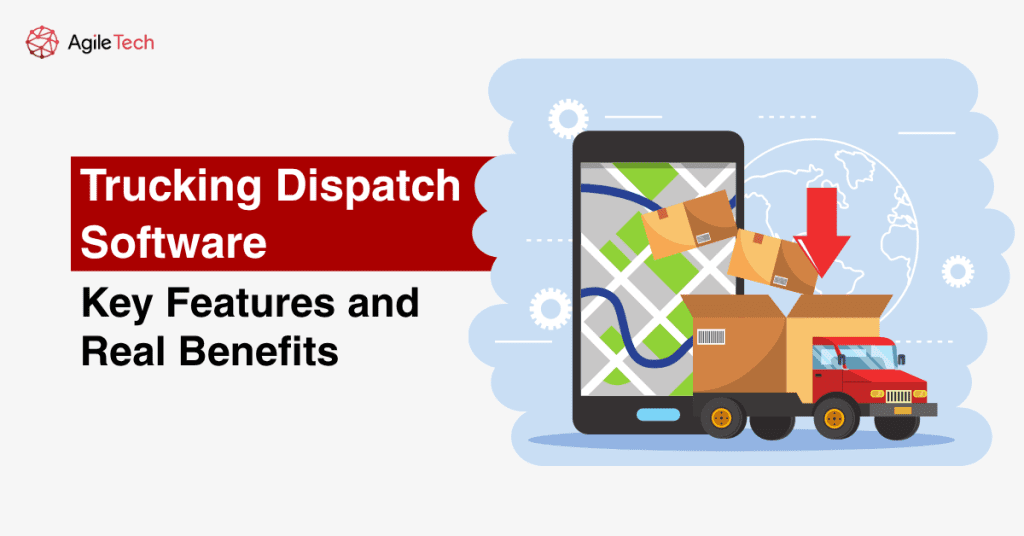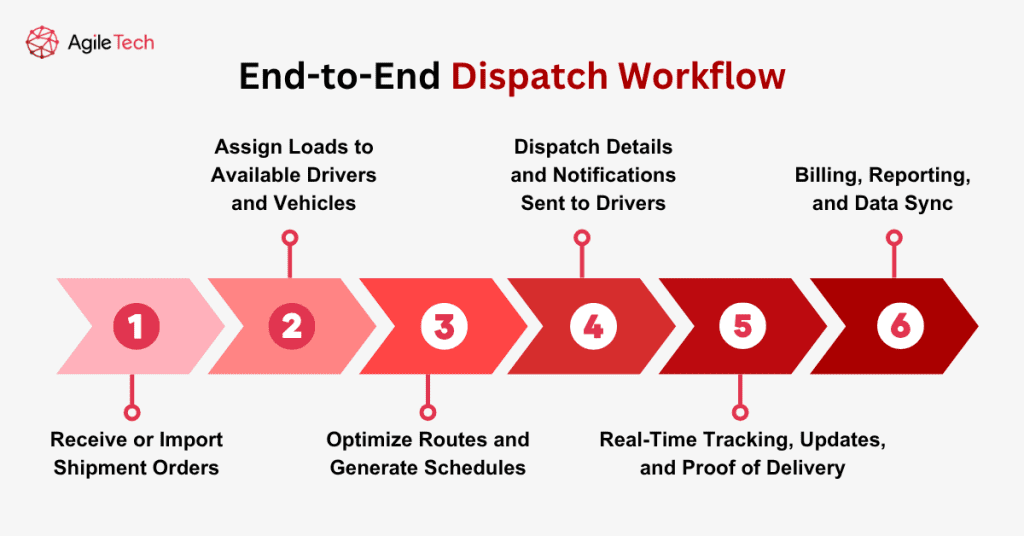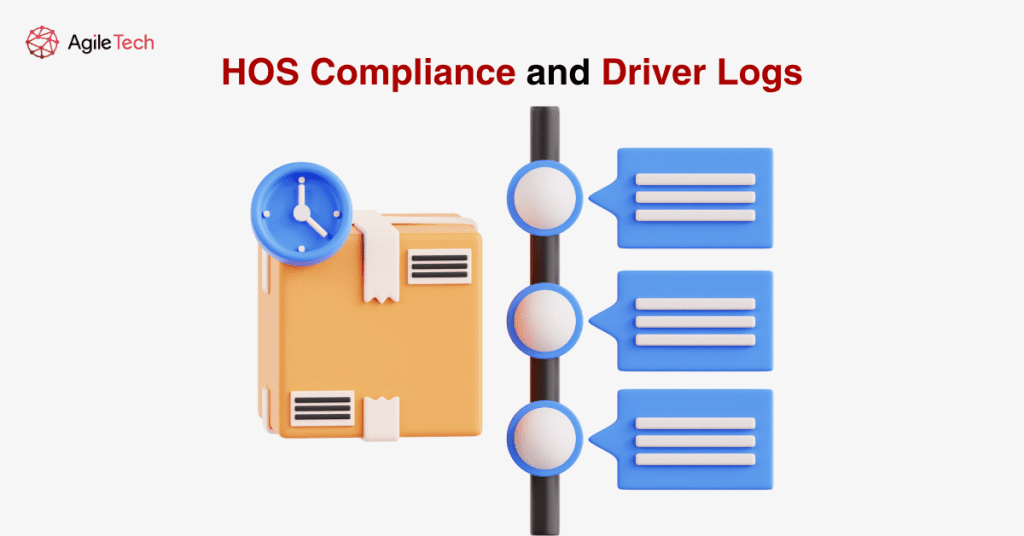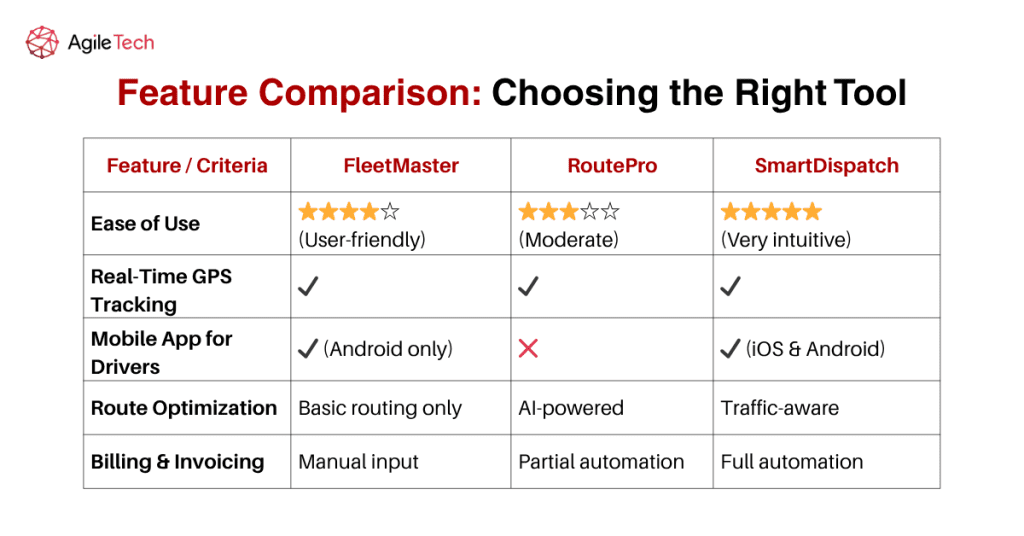Trucking Dispatch Software: Key Features and Real Benefits
Fleet managers face growing pressure to meet delivery deadlines, reduce operational costs, and maintain compliance, often with limited resources. Trucking dispatch software provides a centralized, digital approach to managing drivers, shipments, and routes. In this article, we explain how dispatching software for trucking works, its must-have features, and the real benefits it offers to small and mid-sized trucking companies looking to modernize and grow.

1. Introduction to Dispatch Software for Trucking
Trucking dispatch software is a digital platform that optimizes the coordination of freight operations. It is designed to streamline every step of the dispatching process, from receiving orders to ensuring deliveries are completed successfully. In an industry where timing, accuracy, and reliability are crucial, using software that automates and manages these responsibilities can significantly enhance business performance.
The transportation industry is under constant pressure to meet delivery expectations, manage costs, and stay compliant with evolving regulations. Traditional dispatching methods, while still in use, are increasingly being phased out due to their inherent limitations. Manual data entry, lack of real-time visibility, and miscommunication between drivers and dispatchers can quickly result in operational inefficiencies.
Dispatch software for trucking companies addresses these pain points by providing a centralized system for managing fleet activity. It combines real-time data analytics, GPS tracking, load management, and mobile connectivity to empower dispatchers with the tools needed for optimal decision-making. Whether managing a fleet of five or fifty, companies that embrace digital dispatching solutions gain a competitive advantage.
Another key advantage is the scalability of these solutions. Many platforms are built with modularity in mind, allowing businesses to add features or integrate with third-party systems as they grow. Small trucking companies can start with core dispatch functions and later incorporate more advanced modules like fuel management, maintenance scheduling, or customer portals.
Beyond operational benefits, trucking dispatch software contributes to strategic goals by offering data-driven insights. These insights help identify trends, uncover inefficiencies, and inform long-term planning. For example, analytics dashboards can reveal underperforming routes, high-cost deliveries, or drivers who consistently exceed expectations, enabling better allocation of resources and incentives.
2. How Trucking Dispatch Software Works Step by Step
Understanding the operational workflow of dispatch software is essential to grasping its value. Each step in the dispatch cycle is optimized by software automation and connectivity, transforming manual tasks into streamlined digital processes. Here is a comprehensive look at how dispatching software for trucking works in real-world settings:

Step 1: Receive or Import Shipment Orders
The dispatch cycle begins with receiving shipment requests. These can be created internally by operations managers, received from clients, or automatically imported from integrated platforms such as load boards, transportation management systems (TMS), or electronic data interchange (EDI) systems.
Many dispatching solutions offer real-time syncing with customer portals, enabling clients to place orders directly into the dispatch system. This minimizes the need for manual data entry, speeds up response times, and ensures data consistency across systems. Orders typically include pickup and delivery addresses, cargo details, delivery windows, and special handling instructions.
By consolidating orders into a unified interface, dispatchers gain instant access to all incoming requests. Sophisticated platforms allow for order tagging, categorization by urgency or cargo type, and automated notifications to alert staff of priority loads. Some systems also provide load suggestions based on historical trends or past delivery performance.
Step 2: Assign Loads to Available Drivers and Vehicles
Once orders are received, the next task is matching them to the right drivers and vehicles. This is one of the most critical aspects of dispatching, as poor assignments can lead to delays, regulatory violations, or increased operational costs. Trucking dispatch software uses algorithms to analyze driver availability, vehicle type, current location, load capacity, and compliance status before suggesting the most efficient assignment.
In platforms with AI-powered dispatching engines, assignments can be made automatically based on predefined rules. For example, a company may prioritize assigning refrigerated loads to trucks with cooling systems or schedule drivers with specific certifications for hazardous material shipments.
The software also helps manage driver schedules to avoid overworking, ensuring compliance with Hours of Service (HOS) regulations. Visual dispatch boards and color-coded timelines give managers a quick overview of which drivers are available, in transit, or due for rest breaks.
Step 3: Optimize Routes and Generate Schedules
After assigning shipments, the system calculates the most efficient delivery route. Route optimization considers multiple variables, including current traffic conditions, distance, fuel costs, toll roads, delivery windows, and historical traffic patterns. The goal is to minimize mileage while maximizing on-time performance and fuel efficiency.
Some dispatch platforms integrate with real-time traffic services like Google Maps or HERE Technologies. These integrations allow for dynamic rerouting in response to accidents, road closures, or weather delays. By optimizing the sequence of stops and avoiding congested routes, companies can reduce both travel time and fuel consumption.
Automated scheduling tools help dispatchers visualize delivery timelines and set accurate ETAs. Drivers receive detailed trip plans on their mobile devices, including route maps, turn-by-turn directions, and timing cues. These schedules can be adjusted on the fly, and updates are pushed instantly to all stakeholders.
Step 4: Dispatch Details and Notifications Sent to Drivers
Communication with drivers is critical for successful deliveries. Modern dispatching software includes mobile apps that act as digital control centers for drivers. These apps receive dispatch orders, route details, cargo documentation, and real-time updates directly from the back office.
Push notifications inform drivers of any schedule changes, new assignments, or urgent alerts. Drivers can acknowledge receipt, confirm arrivals or departures, and upload delivery documentation from the same app. In-app messaging reduces the need for phone calls or manual check-ins, improving driver focus and safety.
In multilingual fleets, language settings can be customized to ensure clear understanding. The app interface is typically optimized for minimal distraction, using icons, progress bars, and voice-assisted prompts where necessary.
Step 5: Real-Time Tracking, Updates, and Proof of Delivery
From the dispatcher’s perspective, live tracking provides complete visibility over the fleet. Each truck’s GPS coordinates are updated in real time, enabling dispatchers to monitor delivery progress, anticipate delays, and update clients proactively. Some platforms offer geofencing capabilities, triggering automatic alerts when vehicles enter or exit specific areas.
Proof of delivery (POD) is another crucial component. Drivers can upload signed delivery receipts, photos of the cargo at the drop-off location, or barcode scans. These digital PODs are immediately accessible to the back office and clients, improving transparency and speeding up billing cycles.
In the event of disruptions, such as vehicle breakdowns or missed time windows, the system can escalate issues to supervisors or reassign the load automatically, depending on the software’s configuration.
Step 6: Billing, Reporting, and Data Sync
The final step in the dispatch cycle is administrative wrap-up. Upon successful delivery, the software automatically updates the shipment status, generates an invoice, and records the transaction in linked accounting systems. Billing details are pulled directly from the trip data, reducing the risk of errors or disputes.
Reports are then generated for operational analysis. Metrics such as average delivery time, driver performance, fuel usage, and on-time percentage are displayed in dashboards. Managers use these insights to identify areas for improvement and monitor KPIs.
Advanced platforms may also integrate with maintenance systems, triggering alerts for upcoming services based on mileage or usage. Data synchronization ensures consistency across departments, making it easier to run payroll, conduct audits, and maintain regulatory compliance.
Read more: Fleet Management Software Development: Complete Guide for 2025
3. Key Functions of Dispatch Software for Trucking
The functions of dispatch software go far beyond simply assigning loads. They encompass a wide array of tools designed to optimize performance, enhance communication, and ensure compliance at every level of operations.
3.1. Load Planning & Assignment
Effective load planning balances driver workload, vehicle availability, and delivery requirements. The software enables planners to view all upcoming shipments, match them with appropriate assets, and avoid scheduling conflicts. Drag-and-drop scheduling tools make it easy to assign or reassign loads, while automated logic reduces reliance on human intuition.
Some platforms include predictive load suggestions based on historical performance. For instance, if a driver consistently completes early morning deliveries in a particular region, the system may prioritize future jobs that align with that pattern. This improves driver morale and reduces fuel usage.
3.2. Route Optimization & Real-Time Tracking
Route optimization is critical for minimizing costs and ensuring timely deliveries. Dispatch software uses real-time traffic data, predictive analytics, and weather forecasts to suggest optimal routes. If an unexpected event occurs, such as a road closure or severe storm, the system can recommend alternative paths and notify drivers immediately.
Real-time tracking is equally valuable. It gives operations teams a live map of fleet activity, highlighting vehicles that are idle, in transit, or delayed. Dispatchers can filter by driver, region, or load type to monitor specific areas of interest.
Clients also benefit from real-time visibility. Customer portals allow shippers to view the progress of their deliveries, access documents, and receive automated notifications. This transparency builds trust and reduces the need for status update calls.
Real-time tracking also serves as a foundation for performance reviews. Managers can analyze driver behavior over time, tracking metrics such as average speed, idle time, and delivery punctuality. These insights contribute to more accurate performance evaluations and targeted training initiatives.
3.3. Driver Communication & Document Management
Seamless communication between drivers and dispatchers is essential for resolving issues on the road. Trucking dispatch software typically includes in-app messaging systems, allowing drivers to receive instant updates without leaving the app. This replaces less efficient methods like phone calls and two-way radios.
The software also supports digital documentation. Bills of lading, customs forms, delivery instructions, and PODs can be uploaded, viewed, and shared within the platform. Digitizing documents eliminates paperwork delays, improves recordkeeping, and helps avoid lost or incomplete forms.
Cloud-based document management also supports multi-user access. Dispatchers, drivers, warehouse staff, and accounting teams can view and share the same documents without duplication, ensuring consistency across operations.
3.4. Time and Schedule Management

Managing time effectively is crucial for maintaining compliance and operational efficiency. Dispatch software includes scheduling features that align delivery windows with driver availability and legal driving limits. Companies can program rest periods, manage shifts, and avoid violations of HOS regulations.
Dispatchers can view scheduling conflicts in real-time and reassign loads as needed. Color-coded calendars and alerts make it easy to identify overlaps or missed deadlines. Some systems offer drag-and-drop tools for rescheduling and automated reminders for upcoming dispatches.
For larger fleets, the software can manage time zones and cross-border logistics. This is particularly useful for regional carriers operating across multiple states or provinces, where local regulations may differ.
3.5. Integrated Billing & Invoicing
Trucking dispatch software simplifies back-office operations by automating billing workflows. Once a load is marked as delivered, the software pulls data from the dispatch and generates an invoice. This invoice can be automatically sent to clients and recorded in linked accounting systems.
Invoicing modules typically include templates for different service types, such as full-truckload (FTL), less-than-truckload (LTL), or refrigerated freight. Companies can customize billing fields, apply taxes, and track payment status. Automated reminders are triggered for overdue accounts.
Integration with financial platforms like QuickBooks or Xero eliminates the need for double data entry. It also supports financial reporting by aggregating data from all invoices and expenses into exportable dashboards.
4. Real Benefits of Dispatching Software for Trucking
Trucking dispatch software offers both short-term gains and long-term strategic advantages. For companies competing in time-sensitive and cost-intensive markets, these benefits can significantly impact profitability and reputation.

4.1. Better Operational Control
Dispatching platforms provide a real-time, centralized view of fleet operations. Dispatchers can monitor vehicle statuses, delivery progress, and driver availability on a single dashboard. This consolidated view reduces the time spent switching between systems or communication channels, empowering dispatchers to make timely and informed decisions.
With greater operational control, companies can enforce delivery schedules more effectively, reduce bottlenecks, and enhance load coordination. Whether dealing with a single shipment or managing multiple trips across various states, the improved visibility ensures fewer errors and greater accountability.
4.2. Faster and Smarter Decisions
Access to live data and historical analytics allows companies to respond swiftly to disruptions. If a truck breaks down or a route becomes blocked, dispatchers can reassign loads or reroute drivers immediately. Some platforms even use AI to suggest the best alternatives based on real-time conditions.
Decision-making becomes less reactive and more strategic. Trends in fuel usage, delivery delays, or driver performance can be tracked over time, helping managers optimize plans. This agility is critical in industries with tight delivery windows or high customer service expectations.
4.3. Cost Reduction and Higher Productivity
According to the American Transportation Research Institute, fuel represents over 20% of operating costs for trucking companies. By optimizing routes, reducing idle time, and improving load distribution, dispatch software directly impacts the bottom line.
Administrative savings are also significant. Automating scheduling, documentation, and invoicing reduces labor costs and minimizes human error. Combined, these efficiencies enable companies to handle more shipments with fewer resources, increasing overall productivity.
4.4. Regulatory Compliance Made Simple
Compliance is a growing concern in the transportation sector. Trucking dispatch software includes built-in tools for managing Hours of Service (HOS) rules, electronic logging device (ELD) data, and driver certification records.
Automated alerts help prevent violations before they occur, such as notifying dispatchers when a driver is nearing their HOS limit. Digital logs simplify audits and make it easier to demonstrate compliance during inspections, reducing legal risk and administrative workload.
4.5. Customer Satisfaction Improvements
Today’s clients expect accurate delivery ETAs, live tracking, and timely updates. Dispatching software enables logistics providers to meet these expectations through integrated communication features and transparent service.
By sending real-time notifications to customers, companies can keep clients informed about delays, early arrivals, or delivery issues. Automated feedback requests and satisfaction surveys can also be incorporated to improve service quality continuously.
Happy customers are more likely to return and recommend your services, turning logistics efficiency into a marketing advantage.
Read more: All you need to know about Fleet Management Software 2024
5. How to Choose the Right Software for Trucking
With numerous dispatch platforms available, selecting the right one involves evaluating both current operational needs and future business goals. Here’s how to approach the decision:
5.1. Identify Your Dispatch Workflow and Priorities
Start by mapping your current workflow: How are loads assigned? What tools are used for route planning? Where do communication bottlenecks occur? These questions help identify pain points and clarify what your new system needs to solve.
For example, if scheduling errors are frequent, prioritize tools with automated calendar management. If document tracking is a problem, seek platforms with robust file storage and sharing features. Focus on resolving the biggest daily challenges first.
5.2. Match Features to Your Fleet Size and Type of Operation
Not every platform is built for every business model. Some are designed for enterprise fleets with hundreds of vehicles, while others cater to owner-operators or small businesses.
Look for a solution that balances power with simplicity. Essential features for smaller fleets may include mobile access, customer support, and ease of onboarding. Larger fleets might need APIs, warehouse integration, and advanced analytics. Avoid platforms that overwhelm your team or include unnecessary features.
5.3. Evaluate Customer Support, Security, and Ease of Use
Software performance isn’t just about functionality. It’s also about how well your team can adopt and use it. Choose vendors that offer responsive customer support through live chat, phone, or in-person training.
Security is also critical. The software should comply with data protection standards and offer role-based access control to prevent unauthorized data usage. A clean, intuitive interface ensures that your team can focus on logistics, not software troubleshooting.

Conclusion
Trucking dispatch software is no longer just a competitive advantage; it is a core necessity for efficient and scalable logistics operations. By replacing manual workflows with automation, dispatching tools help businesses improve route planning, reduce operational costs, and enhance fleet visibility. Whether you’re a small trucking company looking to scale or a mid-size carrier aiming to optimize resources, the right dispatch software can transform daily operations and long-term performance.
From load assignments to customer satisfaction, each stage of the delivery process benefits from streamlined, real-time coordination. As the logistics landscape becomes more data-driven and customer-centric, businesses that embrace dispatch software are better positioned to adapt and thrive.
FAQs
If managing deliveries, drivers, and dispatch schedules still means juggling spreadsheets and calls, it might be time for an upgrade. At AgileTech, we don’t offer one-size-fits-all tools; we build trucking dispatch software that adapts to your fleet, not the other way around.
From real-time tracking to smart route planning, automated billing, and driver mobile apps, our custom solutions are crafted for logistics businesses ready to grow. Whether you’re a regional carrier or a nationwide fleet, we help you cut manual work, reduce costs, and deliver on time, every time.